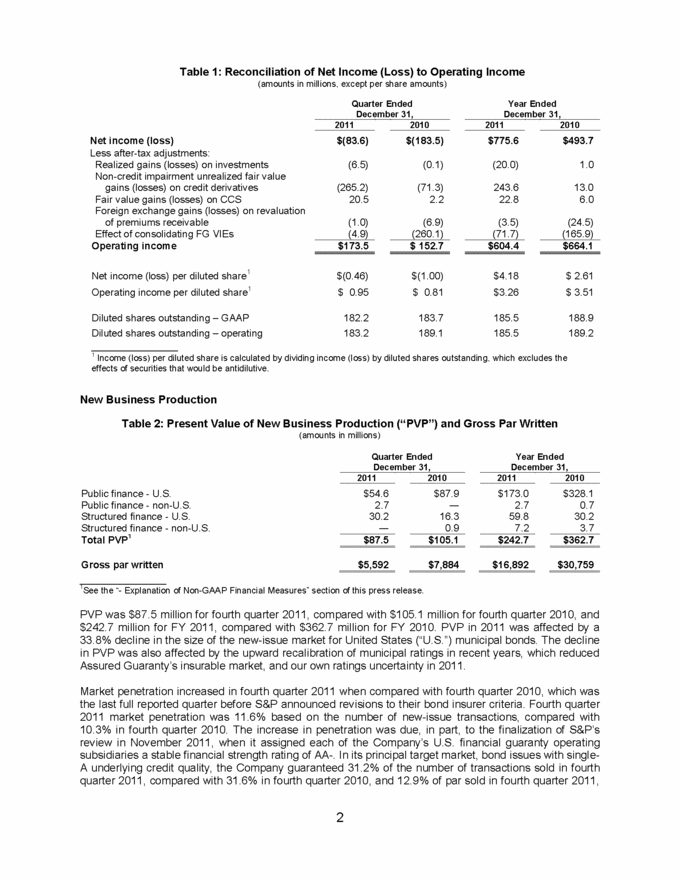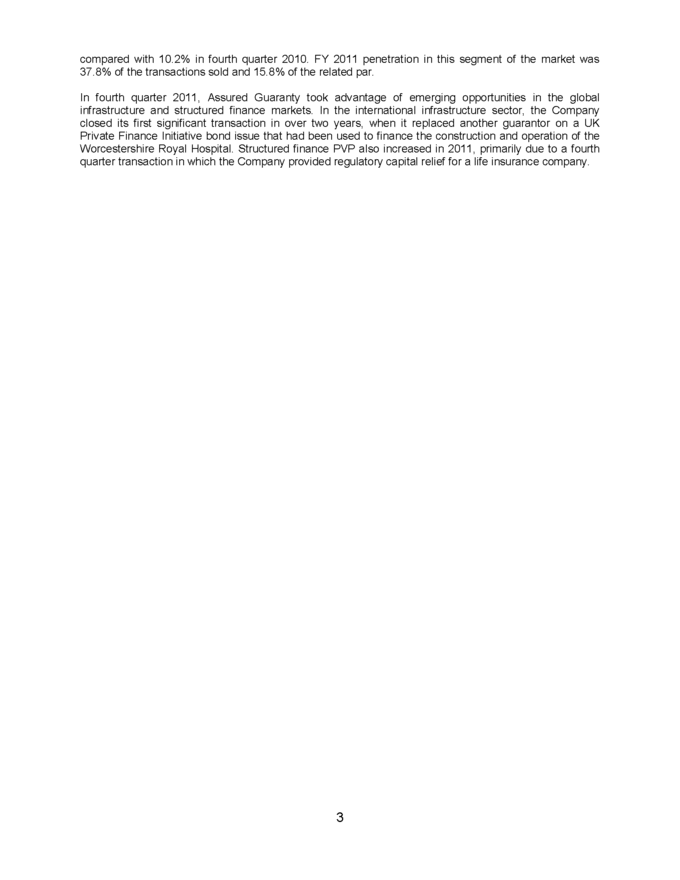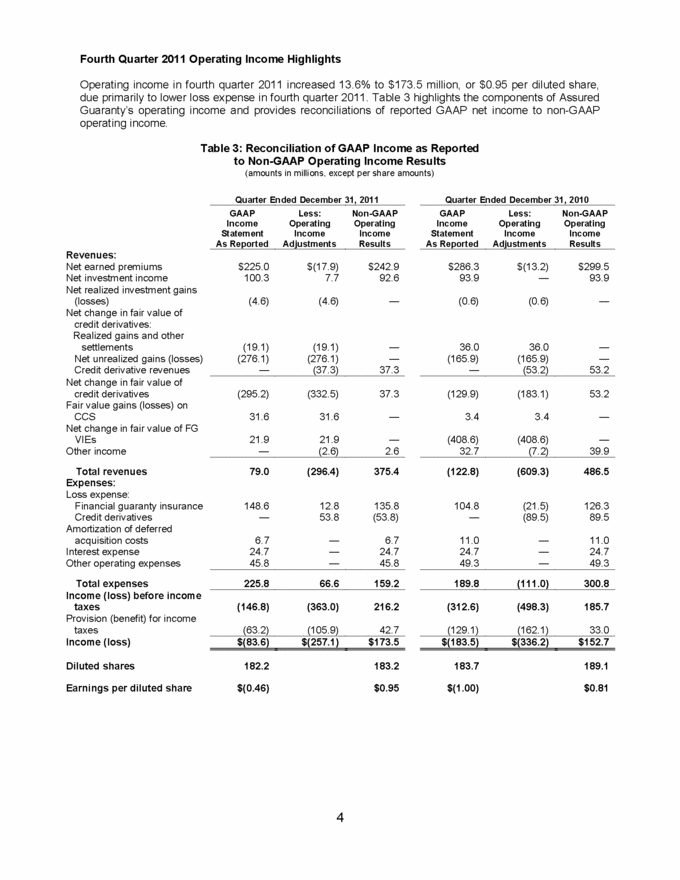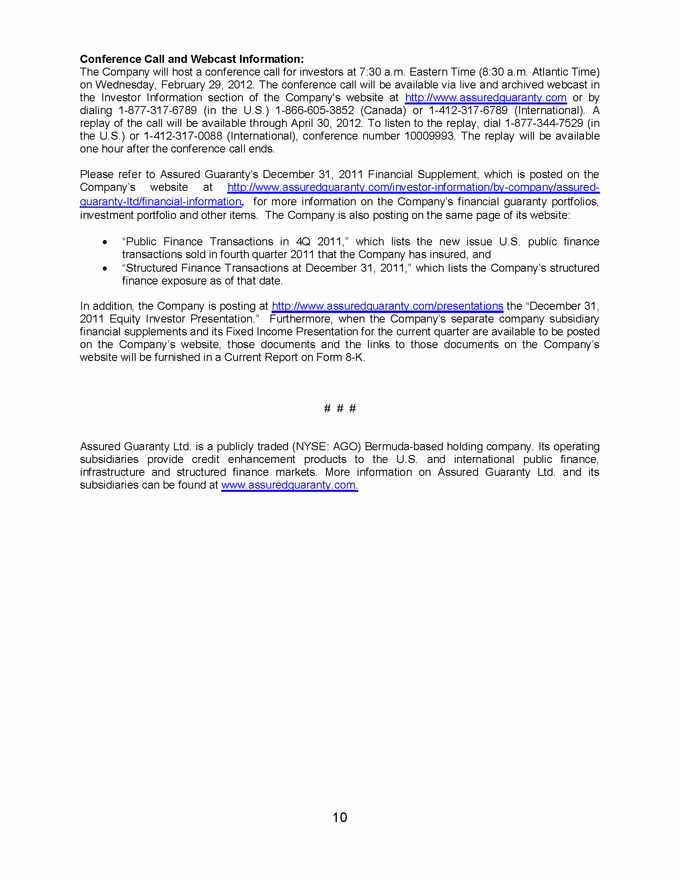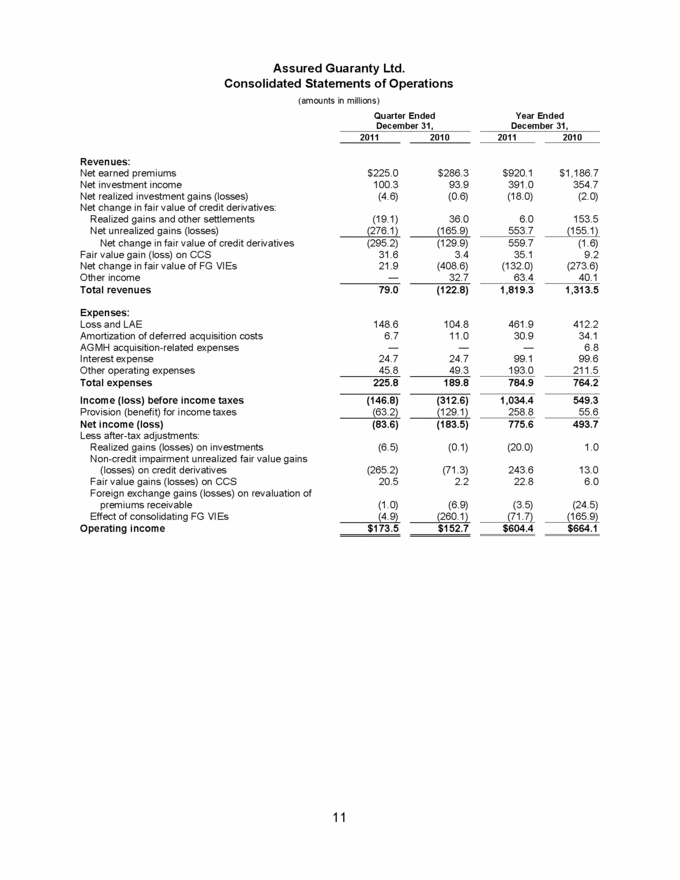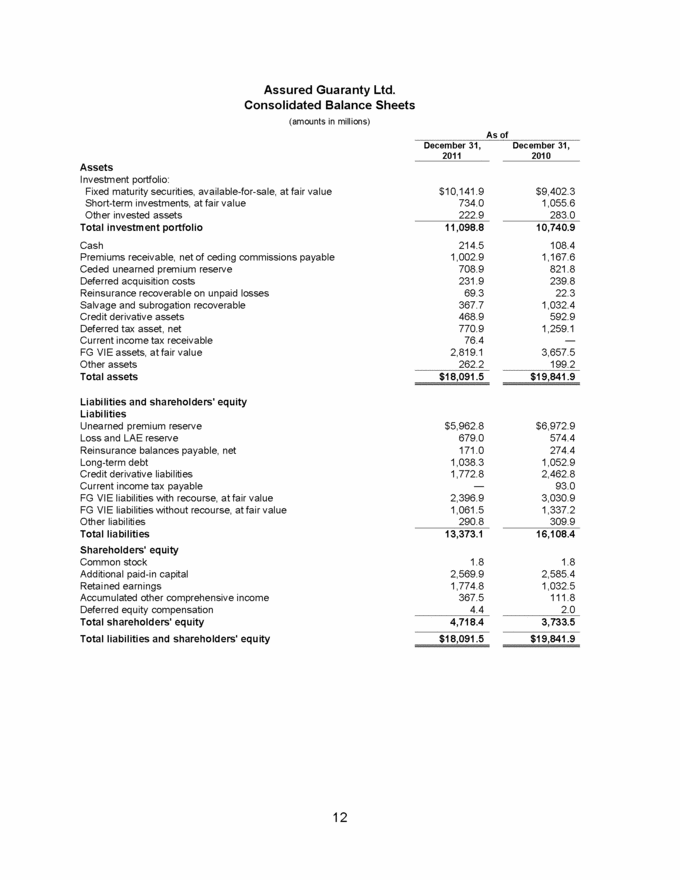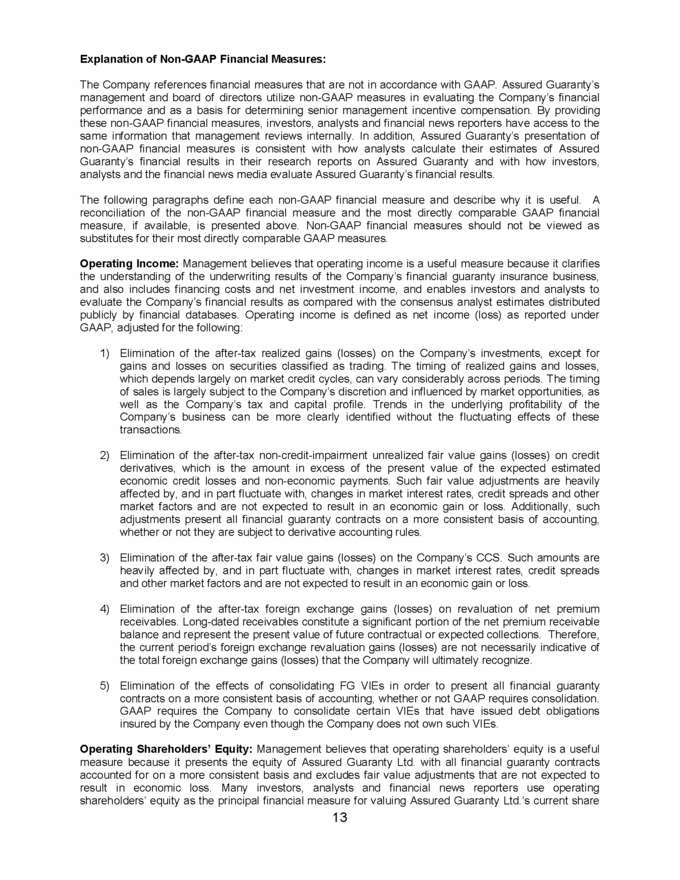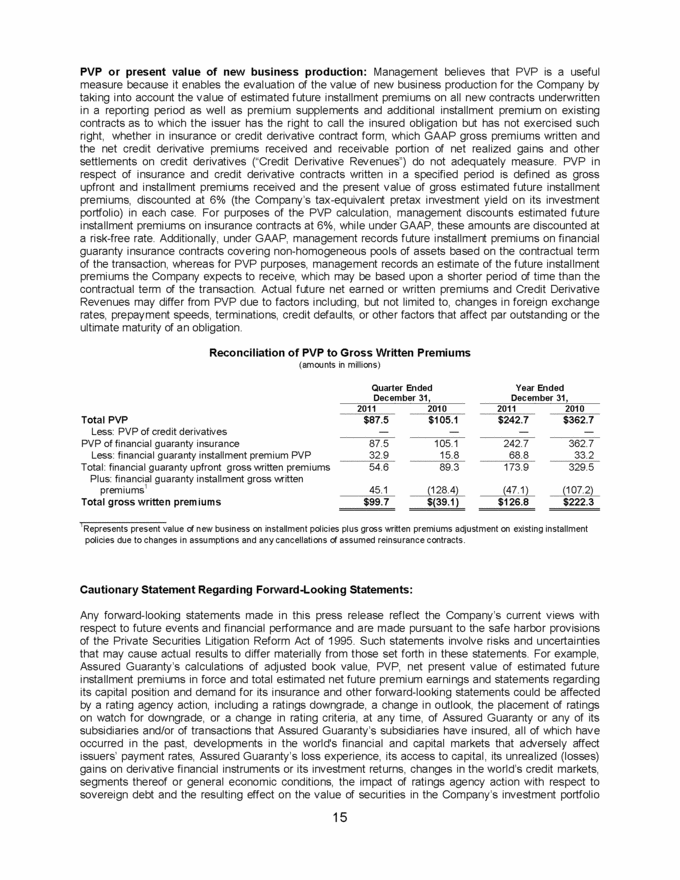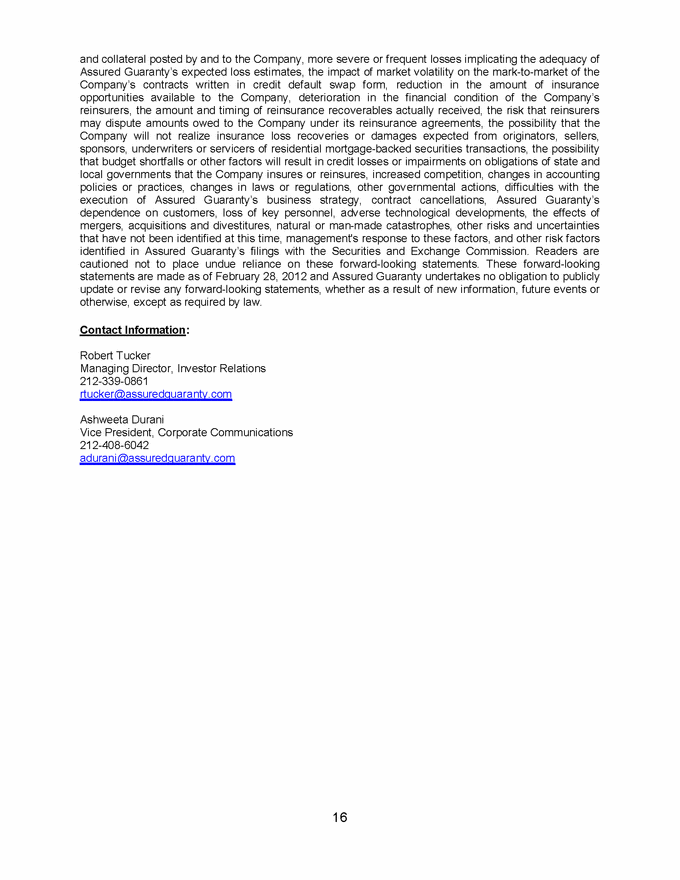Exhibit 99.1
| 1 Assured Guaranty Ltd. Reports Results for Fourth Quarter 2011 Fourth quarter 2011 operating income1 increased 13.6% over fourth quarter 2010 to $173.5 million, or $0.95 per diluted share, bringing full year 2011 operating income to $604.4 million, or $3.26 per diluted share. Fourth quarter 2011 net loss was $83.6 million, or $0.46 per diluted share, representing an improvement of $99.9 million compared with fourth quarter 2010. Full year 2011 net income increased 57.1% to $775.6 million, or $4.18 per diluted share. Net income includes non-economic net unrealized fair value gains and losses2. Shareholders’ equity per share increased 27.4% since year-end 2010 and operating shareholders’ equity1 per share increased 11.7%. Adjusted book value1 per share also increased to $49.32, compared with $48.92 for year-end 2010. Hamilton, Bermuda, February 28, 2012 – Assured Guaranty Ltd. (NYSE: AGO) (“AGL” and, together with its subsidiaries, “Assured Guaranty” or the “Company”) announced today financial results for the year ended December 31, 2011 (“FY 2011”) and for the three-month period ended December 31, 2011 (“fourth quarter 2011”). The Company reported operating income for fourth quarter 2011 of $173.5 million, or $0.95 per diluted share, which represents a 13.6% increase compared with the three-month period ended December 31, 2010 (“fourth quarter 2010”), primarily as a result of lower loss expense3 included in operating income. This brings FY 2011 operating income to $604.4 million, or $3.26 per diluted share. The comparable operating income for the year ended December 31, 2010 (“FY 2010”) was $664.1 million, or $3.51 per diluted share. Operating income reflects certain adjustments to net income, including the removal of the effects of changes in fair value that are not expected to result in economic loss (“non-economic net unrealized fair value gains and losses”). Fourth quarter 2011 GAAP net loss of $83.6 million, or $0.46 per diluted share, was a $99.9 million improvement over fourth quarter 2010 net loss of $183.5 million, or $1.00 per diluted share. In FY 2011 net income increased 57.1% to $775.6 million, or $4.18 per diluted share, compared with $493.7 million, or $2.61 per diluted share, in FY 2010. See Table 1 for a reconciliation of net income to operating income. “Our near-record operating income results were impressive in 2011, a year marked by uncertainty about our ratings, persistent problems in the economy, a steep decline in municipal issuance and delayed recovery in structured and international infrastructure finance markets,” said Dominic Frederico, President and CEO. “In 2011 we strengthened our rating agency capital position, developed new business opportunities, and mitigated a substantial amount of losses through our R&W recoveries.” 1 Operating income, operating shareholders’ equity and adjusted book value are financial measures that are not in accordance with accounting principles generally accepted in the United States of America (“GAAP”) and are therefore called “non-GAAP financial measures.” Please see the “Explanation of Non-GAAP Financial Measures” section of this press release. 2 Represents the non-economic fair value adjustments related to credit derivatives, financial guaranty variable interest entities (“FG VIEs”) and committed capital securities (“CCS”). These non-economic changes in fair value represent the components of changes in fair value in excess of net expected loss that are expected to reverse to zero by contract maturity and are removed from net income to arrive at operating income. 3Loss expense recognized in operating income is determined based on the financial guaranty insurance accounting model for all contracts, including credit derivatives and those related to FG VIEs. Loss expense is a function of changes in economic loss, including the benefit for recoveries of breaches of representations and warranties (“R&W”), and amortization of deferred premium revenue. |
| 2 Table 1: Reconciliation of Net Income (Loss) to Operating Income (amounts in millions, except per share amounts) Quarter Ended December 31, Year Ended December 31, 2011 2010 2011 2010 Net income (loss) $(83.6) $(183.5) $775.6 $493.7 Less after-tax adjustments: Realized gains (losses) on investments (6.5) (0.1) (20.0) 1.0 Non-credit impairment unrealized fair value gains (losses) on credit derivatives (265.2) (71.3) 243.6 13.0 Fair value gains (losses) on CCS 20.5 2.2 22.8 6.0 Foreign exchange gains (losses) on revaluation of premiums receivable (1.0) (6.9) (3.5) (24.5) Effect of consolidating FG VIEs (4.9) (260.1) (71.7) (165.9) Operating income $173.5 $ 152.7 $604.4 $664.1 Net income (loss) per diluted share1 $(0.46) $(1.00) $4.18 $ 2.61 Operating income per diluted share1 $ 0.95 $ 0.81 $3.26 $ 3.51 Diluted shares outstanding – GAAP 182.2 183.7 185.5 188.9 Diluted shares outstanding – operating 183.2 189.1 185.5 189.2 1 Income (loss) per diluted share is calculated by dividing income (loss) by diluted shares outstanding, which excludes the effects of securities that would be antidilutive. New Business Production Table 2: Present Value of New Business Production (“PVP”) and Gross Par Written (amounts in millions) Quarter Ended December 31, Year Ended December 31, 2011 2010 2011 2010 Public finance - U.S. $54.6 $87.9 $173.0 $328.1 Public finance - non-U.S. — 2.7 2.7 0.7 Structured finance - U.S. 30.2 16.3 59.8 30.2 Structured finance - non-U.S. —0.9 7.2 3.7 Total PVP1 $87.5 $105.1 $242.7 $362.7 Gross par written $5,592 $7,884 $16,892 $30,759 1See the “- Explanation of Non-GAAP Financial Measures” section of this press release. PVP was $87.5 million for fourth quarter 2011, compared with $105.1 million for fourth quarter 2010, and $242.7 million for FY 2011, compared with $362.7 million for FY 2010. PVP in 2011 was affected by a 33.8% decline in the size of the new-issue market for United States (“U.S.”) municipal bonds. The decline in PVP was also affected by the upward recalibration of municipal ratings in recent years, which reduced Assured Guaranty’s insurable market, and our own ratings uncertainty in 2011. Market penetration increased in fourth quarter 2011 when compared with fourth quarter 2010, which was the last full reported quarter before S&P announced revisions to their bond insurer criteria. Fourth quarter 2011 market penetration was 11.6% based on the number of new-issue transactions, compared with 10.3% in fourth quarter 2010. The increase in penetration was due, in part, to the finalization of S&P’s review in November 2011, when it assigned each of the Company’s U.S. financial guaranty operating subsidiaries a stable financial strength rating of AA-. In its principal target market, bond issues with single- A underlying credit quality, the Company guaranteed 31.2% of the number of transactions sold in fourth quarter 2011, compared with 31.6% in fourth quarter 2010, and 12.9% of par sold in fourth quarter 2011, |
| 3 compared with 10.2% in fourth quarter 2010. FY 2011 penetration in this segment of the market was 37.8% of the transactions sold and 15.8% of the related par. In fourth quarter 2011, Assured Guaranty took advantage of emerging opportunities in the global infrastructure and structured finance markets. In the international infrastructure sector, the Company closed its first significant transaction in over two years, when it replaced another guarantor on a UK Private Finance Initiative bond issue that had been used to finance the construction and operation of the Worcestershire Royal Hospital. Structured finance PVP also increased in 2011, primarily due to a fourth quarter transaction in which the Company provided regulatory capital relief for a life insurance company. |
| 4 Fourth Quarter 2011 Operating Income Highlights Operating income in fourth quarter 2011 increased 13.6% to $173.5 million, or $0.95 per diluted share, due primarily to lower loss expense in fourth quarter 2011. Table 3 highlights the components of Assured Guaranty’s operating income and provides reconciliations of reported GAAP net income to non-GAAP operating income. Table 3: Reconciliation of GAAP Income as Reported to Non-GAAP Operating Income Results (amounts in millions, except per share amounts) Quarter Ended December 31, 2011 Quarter Ended December 31, 2010 GAAP Income Statement As Reported Less: Operating Income Adjustments Non-GAAP Operating Income Results GAAP Income Statement As Reported Less: Operating Income Adjustments Non-GAAP Operating Income Results Revenues: Net earned premiums $225.0 $(17.9) $242.9 $286.3 $(13.2) $299.5 Net investment income 100.3 7.7 92.6 93.9 — 93.9 Net realized investment gains (losses) (4.6) (4.6) — (0.6) (0.6) — Net change in fair value of credit derivatives: Realized gains and other settlements (19.1) (19.1) — 36.0 36.0 — Net unrealized gains (losses) (276.1) (276.1) — (165.9) (165.9) — Credit derivative revenues — (37.3) 37.3 — (53.2) 53.2 Net change in fair value of credit derivatives (295.2) (332.5) 37.3 (129.9) (183.1) 53.2 Fair value gains (losses) on CCS 31.6 31.6 — 3.4 3.4 — Net change in fair value of FG VIEs 21.9 21.9 — (408.6) (408.6) — Other income — (2.6) 2.6 32.7 (7.2) 39.9 Total revenues 79.0 (296.4) 375.4 (122.8) (609.3) 486.5 Expenses: Loss expense: Financial guaranty insurance 148.6 12.8 135.8 104.8 (21.5) 126.3 Credit derivatives — 53.8 (53.8) — (89.5) 89.5 Amortization of deferred acquisition costs 6.7 — 6.7 11.0 — 11.0 Interest expense 24.7 — 24.7 24.7 — 24.7 Other operating expenses 45.8 — 45.8 49.3 — 49.3 Total expenses 225.8 66.6 159.2 189.8 (111.0) 300.8 Income (loss) before income taxes (146.8) (363.0) 216.2 (312.6) (498.3) 185.7 Provision (benefit) for income taxes (63.2) (105.9) 42.7 (129.1) (162.1) 33.0 Income (loss) $(83.6) $(257.1) $173.5 $(183.5) $(336.2) $152.7 Diluted shares 182.2 183.2 183.7 189.1 Earnings per diluted share $(0.46) $0.95 $(1.00) $0.81 |
| 5 Where significant changes occurred, components of fourth quarter 2011 operating income are compared with the same item in fourth quarter 2010. Net earned premiums: Net earned premiums included in fourth quarter 2011 operating income were $242.9 million. The comparable fourth quarter 2010 net earned premiums were $299.5 million, which reflected a larger portfolio of inforce business at that time, particularly the structured finance portfolio. Net earned premiums from refundings and accelerations were $47.8 million in fourth quarter 2011 and $38.0 million in fourth quarter 2010. Credit derivative revenues: Credit derivative revenues included in fourth quarter 2011 operating income were $37.3 million. The comparable fourth quarter 2010 credit derivative revenues were $53.2 million, which was based on a larger portfolio of structured finance business at that time. Other income: Other income in fourth quarter 2010 included $32.7 million of commutation gains related to the cancellation of reinsurance contracts. We had no commutations in fourth quarter 2011. Loss expense: The Company’s fourth quarter 2011 loss expense decreased 62.0% to $82.0 million ($47.5 million after tax, or $0.26 per diluted share). Fourth quarter 2010 loss expense was $215.8 million ($153.6 million after tax, or $0.84 per diluted share). Loss expense declined in U.S. residential mortgage-backed securities (“RMBS”) and other structured finance sectors, but was offset in part by an increase in the international public finance sector, where the Company increased its expected loss estimate for its exposures to Greece sovereign debt obligations. See “Economic Loss Development.” Operating expenses: Operating expenses decreased 7.1% to $45.8 million in fourth quarter 2011 due primarily to lower compensation costs. Income taxes: Fourth quarter 2011 effective tax rate on operating income was 19.7%, compared with 17.8% in fourth quarter 2010. |
| 6 2011 Operating Income Highlights Operating income in FY 2011 was $604.4 million, or $3.26 per diluted share. Operating income in FY 2010 was $664.1 million, or $3.51 per diluted share, including a $55.8 million tax benefit related to an amended tax return filed for Assured Guaranty Municipal Holdings Inc. (“AGMH”) for a period prior to its 2009 acquisition by Assured Guaranty. Table 4 highlights the components of Assured Guaranty’s operating income and provides reconciliations of reported GAAP net income to non-GAAP operating income. Table 4: Reconciliation of FY 2011 and FY 2010 GAAP Income as Reported to FY 2011 and FY 2010 Non-GAAP Operating Income Results (amounts in millions, except per share amounts) Year Ended December 31, 2011 Year Ended December 31, 2010 GAAP Income Statement As Reported Less: Operating Income Adjustments Non-GAAP Operating Income Results GAAP Income Statement As Reported Less: Operating Income Adjustments Non-GAAP Operating Income Results Revenues: Net earned premiums $920.1 $(74.7) $994.8 $1,186.7 $(47.6) $1,234.3 Net investment income 391.0 3.0 388.0 354.7 — 354.7 Net realized investment gains (losses) (18.0) (18.0) — (2.0) (2.0) — Net change in fair value of credit derivatives: Realized gains and other settlements 6.0 6.0 — 153.5 153.5 — Net unrealized gains (losses) 553.7 553.7 — (155.1) (155.1) — Credit derivative revenues — (188.1) 188.1 — (210.3) 210.3 Net change in fair value of credit derivatives 559.7 371.6 188.1 (1.6) (211.9) 210.3 Fair value gains (losses) on CCS 35.1 35.1 — 9.2 9.2 — Net change in fair value of FG VIEs (132.0) (132.0) — (273.6) (273.6) — Other income 63.4 17.2 46.2 40.1 (20.4) 60.5 Total revenues 1,819.3 202.2 1,617.1 1,313.5 (546.3) 1,859.8 Expenses: Loss expense: Financial guaranty insurance 461.9 (92.7) 554.6 412.2 (65.9) 478.1 Credit derivatives — 61.3 (61.3) — (209.4) 209.4 Amortization of deferred acquisition costs 30.9 — 30.9 34.1 — 34.1 AGMH acquisition-related expenses — — — 6.8 — 6.8 Interest expense 99.1 — 99.1 99.6 — 99.6 Other operating expenses 193.0 — 193.0 211.5 — 211.5 Total expenses 784.9 (31.4) 816.3 764.2 (275.3) 1,039.5 Income (loss) before income taxes 1,034.4 233.6 800.8 549.3 (271.0) 820.3 Provision (benefit) for income taxes 258.8 62.4 196.4 55.6 (100.6) 156.2 Income (loss) $775.6 $171.2 $604.4 $493.7 $(170.4) $664.1 Diluted shares 185.5 185.5 188.9 189.2 Earnings per diluted share $4.18 $3.26 $2.61 $3.51 |
| 7 Where significant changes occurred, components of FY 2011 operating income are compared with the same item for FY 2010. Net earned premiums: Net earned premiums included in FY 2011 operating income were $994.8 million. The comparable FY 2010 net earned premiums were $1,234.3 million, which reflected a larger portfolio of inforce business at that time, particularly the structured finance portfolio. Net earned premiums from refundings and accelerations were $125.2 million for FY 2011 compared with $90.0 million for FY 2010. Net investment income: Net investment income included in FY 2011 operating income increased 9.4% to $388.0 million due to a shift from cash and short term assets to the fixed income portfolio and additional earnings on higher invested asset balances. The amortized cost of fixed maturities and short-term investments averaged $10.5 billion in 2011, compared with $10.3 billion in 2010. The pretax book yield was 4.00% at December 31, 2011 and 3.72% at December 31, 2010. Credit derivative revenues: Credit derivative revenues included in FY 2011 operating income were $188.1 million. The comparable FY 2010 credit derivative revenues were $210.3 million, which was based on a larger portfolio of inforce structured finance business at that time. Loss expense: Loss expense in FY 2011 decreased 28.2% to $493.3 million ($346.6 million after tax, or $1.87 per diluted share) compared with FY 2010. The most significant decline was in the U.S. RMBS sector (26.9% lower than FY 2010), which benefitted from increases in the R&W benefit attributable to each of the Company’s R&W providers, but most notably Bank of America, which was the Company’s largest R&W provider. As previously reported, the Company reached an agreement with Bank of America on April 14, 2011 (the “Bank of America Agreement”) to cover $1.1 billion of losses for eight covered second lien U.S. RMBS transactions, and 80% of losses for 21 covered first lien transactions up to first lien collateral losses of $6.6 billion. The R&W benefit within loss expense in FY 2011 was approximately $525 million, which largely offset loss development related to the slower than expected recovery in the U.S. mortgage market as indicated by the continuation of elevated levels of early stage delinquencies and higher expected loss severities. Loss development also includes non-credit-impairment-related declines that resulted from the decline in the risk-free rates used to discount expected loss. Public finance loss expense increased primarily due to $33.0 million related to the Company’s exposure to Greece. See “Economic Loss Development.” Operating expenses: Operating expenses decreased 8.7% to $193.0 million for FY 2011 due primarily to lower compensation costs. Income taxes: Assured Guaranty’s tax rate on operating income fluctuates from quarter to quarter primarily as a result of the amount of operating income or loss for the Company’s primary reinsurance subsidiary Assured Guaranty Re Ltd. The FY 2011 effective tax rate on operating income was 24.5%, compared with 19.1% in FY 2010. The effective tax rate on operating income in FY 2010 was affected by a $55.8 million tax benefit related to an amended tax return filed for AGMH for a period prior to its 2009 acquisition by Assured Guaranty. |
| 8 Economic Loss Development Economic loss development, which measures the change in total expected loss to be paid due to changes in assumptions based on observed market trends, changes in discount rates, accretion of discount on expected loss to be paid and the effects of loss mitigation efforts, is the principal measure that Assured Guaranty uses to evaluate the Company’s loss experience in the insured portfolio. Expected loss to be paid includes all transactions insured by the Company whether written in financial guaranty or credit derivative form, including FG VIEs. Table 5 provides a roll forward of net expected loss to be paid for fourth quarter 2011 and FY 2011. Table 5: Roll Forward of Net Expected Loss to be Paid on Financial Guaranty Insurance Contracts and Credit Derivatives (amounts in millions) Quarter Ended December 31, 2011 Financial Guaranty Insurance Contracts and Credit Derivatives Net Expected Loss to be Paid as of September 30, 2011 Economic Loss Development During Quarter Ended December 31, 2011 Loss (Paid) Recovered Quarter Ended December 31, 2011 Net Expected Loss to be Paid as of December 31, 2011 Before R&W: U.S. RMBS $ 2,585.2 $ (22.1) $ (282.5) $ 2,280.6 Other 497.9 12.0 (36.7) 473.2 Total before R&W 3,083.1 (10.1) (319.2) 2,753.8 R&W for U.S. RMBS (1,764.0) 38.6 75.6 (1,649.8) Total net of R&W $ 1,319.1 $ 28.5 $ (243.6) $ 1,104.0 Year Ended December 31, 2011 Financial Guaranty Insurance Contracts and Credit Derivatives Net Expected Loss to be Paid as of December 31, 2010 Economic Loss Development During Year Ended December 31, 2011 Loss (Paid) Recovered Year Ended December 31, 2011 Net Expected Loss to be Paid as of December 31, 2011 Before R&W: U.S. RMBS $ 2,293.1 $ 1,039.2 $(1,051.7) $ 2,280.6 Other 440.4 123.1 (90.3) 473.2 Total before R&W 2,733.5 1,162.3 (1,142.0) 2,753.8 R&W for U.S. RMBS (1,670.7) (1,038.5) 1,059.4 (1,649.8) Total net of R&W $ 1,062.8 $ 123.8 $ (82.6) $ 1,104.0 Total economic loss development was $28.5 million ($19.9 million after tax) in fourth quarter 2011. U.S. RMBS contributed $16.5 million to the total economic loss development in fourth quarter 2011, representing the continuation of higher than projected levels of early stage delinquencies and more pessimistic severity scenarios in the expected loss models for certain classes of U.S. RMBS insured obligations, substantially offset by improvements in liquidation rates and the effects of ongoing loss mitigation. An increase in net expected loss related to Greek sovereign debt exposures of $36.3 million and higher expected loss adjustment expenses (“LAE”), was offset by improvements in trust preferred securities and other transactions, primarily in the other structured finance sector. In fourth quarter 2011, due to the uncertainty of the outcome in Greece’s debt crisis, the Company probability-weighted several possible outcomes and increased its net expected loss to be paid to $64.7 million on a gross basis (or $42.6 million on a net basis) as of December 31, 2011. Changes in risk-free rates did not significantly affect expected loss during fourth quarter 2011. |
| 9 Total economic loss development was $123.8 million ($116.0 million after tax) for FY 2011. Economic loss development, before consideration of R&W benefit, was a function of several factors including: increasing the assumed period of time for reaching the final conditional default rate, updating probability weightings of its various scenarios, increasing severity on first lien transactions as well as adding a more pessimistic scenario for first lien transactions which projects a delay in the assumed recovery in the housing market. Additionally, due to the decline in interest rates in 2011 and the GAAP requirement to update discount rates at each reporting period to the then-current risk-free rates, the economic loss development increased by approximately $200 million in 2011. Higher expected LAE also contributed to economic loss development in FY. Shareholders’ Equity and Adjusted Book Value Shareholders’ equity (“book value”) per share at December 31, 2011 increased 27.4% since December 31, 2010 to $25.89. The increase in 2011 resulted primarily from the Company’s $775.6 million of net income for the year, and unrealized gains on the investment portfolio. Operating shareholders’ equity per share increased approximately 11.7% to $28.91 at December 31, 2011. The increase in operating shareholders’ equity per share resulted principally from the Company’s $604.4 million in operating income for the year. Adjusted book value per share was $49.32 at December 31, 2011, and $48.92, at December 31, 2010. Table 6 provides a reconciliation of book value to operating shareholders’ equity and to adjusted book value. Table 6: Reconciliation of Book Value to Operating Shareholders’ Equity and Adjusted Book Value (amounts in millions, except per share amounts) As of December 31, 2011 December 31, 2010 Book value $4,718.4 $3,733.5 Less after-tax adjustments: Effect of consolidating FG VIEs (405.2) (371.4) Non-credit impairment unrealized fair value gains (losses) on credit derivatives (498.0) (763.0) Fair value gains (losses) on CCS 35.0 12.2 Unrealized gain (loss) on investment portfolio excluding foreign exchange effect 318.4 101.2 Operating shareholders' equity 5,268.2 4,754.5 After-tax adjustments: Less: Deferred acquisition costs, after tax 240.9 248.4 Plus: Net present value of estimated net future credit derivative revenue 302.3 424.8 Plus: Net unearned premium reserve on financial guaranty contracts in excess of expected loss to be expensed 3,658.0 4,058.0 Adjusted book value $8,987.6 $8,988.9 Shares outstanding at the end of period 182.2 183.7 Per share: Book value $25.89 $20.32 Operating shareholders' equity 28.91 25.88 Adjusted book value 49.32 48.92 |
| 10 Conference Call and Webcast Information: The Company will host a conference call for investors at 7:30 a.m. Eastern Time (8:30 a.m. Atlantic Time) on Wednesday, February 29, 2012. The conference call will be available via live and archived webcast in the Investor Information section of the Company's website at http://www.assuredguaranty.com or by dialing 1-877-317-6789 (in the U.S.) 1-866-605-3852 (Canada) or 1-412-317-6789 (International). A replay of the call will be available through April 30, 2012. To listen to the replay, dial 1-877-344-7529 (in the U.S.) or 1-412-317-0088 (International), conference number 10009993. The replay will be available one hour after the conference call ends. Please refer to Assured Guaranty’s December 31, 2011 Financial Supplement, which is posted on the Company’s website at http://www.assuredguaranty.com/investor-information/by-company/assured-guaranty- ltd/financial-information, for more information on the Company’s financial guaranty portfolios, investment portfolio and other items. The Company is also posting on the same page of its website: “Public Finance Transactions in 4Q 2011,” which lists the new issue U.S. public finance transactions sold in fourth quarter 2011 that the Company has insured, and “Structured Finance Transactions at December 31, 2011,” which lists the Company’s structured finance exposure as of that date. In addition, the Company is posting at http://www.assuredguaranty.com/presentations the “December 31, 2011 Equity Investor Presentation.” Furthermore, when the Company’s separate company subsidiary financial supplements and its Fixed Income Presentation for the current quarter are available to be posted on the Company’s website, those documents and the links to those documents on the Company’s website will be furnished in a Current Report on Form 8-K. # # # Assured Guaranty Ltd. is a publicly traded (NYSE: AGO) Bermuda-based holding company. Its operating subsidiaries provide credit enhancement products to the U.S. and international public finance, infrastructure and structured finance markets. More information on Assured Guaranty Ltd. and its subsidiaries can be found at www.assuredguaranty.com. |
| 11 Assured Guaranty Ltd. Consolidated Statements of Operations (amounts in millions) Quarter Ended December 31, Year Ended December 31, 2011 2010 2011 2010 Revenues: Net earned premiums $225.0 $286.3 $920.1 $1,186.7 Net investment income 100.3 93.9 391.0 354.7 Net realized investment gains (losses) (4.6) (0.6) (18.0) (2.0) Net change in fair value of credit derivatives: Realized gains and other settlements (19.1) 36.0 6.0 153.5 Net unrealized gains (losses) (276.1) (165.9) 553.7 (155.1) Net change in fair value of credit derivatives (295.2) (129.9) 559.7 (1.6) Fair value gain (loss) on CCS 31.6 3.4 35.1 9.2 Net change in fair value of FG VIEs 21.9 (408.6) (132.0) (273.6) Other income — 32.7 63.4 40.1 Total revenues 79.0 (122.8) 1,819.3 1,313.5 Expenses: Loss and LAE 148.6 104.8 461.9 412.2 Amortization of deferred acquisition costs 6.7 11.0 30.9 34.1 AGMH acquisition-related expenses — — — 6.8 Interest expense 24.7 24.7 99.1 99.6 Other operating expenses 45.8 49.3 193.0 211.5 Total expenses 225.8 189.8 784.9 764.2 Income (loss) before income taxes (146.8) (312.6) 1,034.4 549.3 Provision (benefit) for income taxes (63.2) (129.1) 258.8 55.6 Net income (loss) (83.6) (183.5) 775.6 493.7 Less after-tax adjustments: Realized gains (losses) on investments (6.5) (0.1) (20.0) 1.0 Non-credit impairment unrealized fair value gains (losses) on credit derivatives (265.2) (71.3) 243.6 13.0 Fair value gains (losses) on CCS 20.5 2.2 22.8 6.0 Foreign exchange gains (losses) on revaluation of premiums receivable (1.0) (6.9) (3.5) (24.5) Effect of consolidating FG VIEs (4.9) (260.1) (71.7) (165.9) Operating income $173.5 $152.7 $604.4 $664.1 |
| 12 Assured Guaranty Ltd. Consolidated Balance Sheets (amounts in millions) As of December 31, 2011 December 31, 2010 Assets Investment portfolio: Fixed maturity securities, available-for-sale, at fair value $10,141.9 $9,402.3 Short-term investments, at fair value 734.0 1,055.6 Other invested assets 222.9 283.0 Total investment portfolio 11,098.8 10,740.9 Cash 214.5 108.4 Premiums receivable, net of ceding commissions payable 1,002.9 1,167.6 Ceded unearned premium reserve 708.9 821.8 Deferred acquisition costs 231.9 239.8 Reinsurance recoverable on unpaid losses 69.3 22.3 Salvage and subrogation recoverable 367.7 1,032.4 Credit derivative assets 468.9 592.9 Deferred tax asset, net 770.9 1,259.1 Current income tax receivable 76.4 — FG VIE assets, at fair value 2,819.1 3,657.5 Other assets 262.2 199.2 Total assets $18,091.5 $19,841.9 Liabilities and shareholders' equity Liabilities Unearned premium reserve $5,962.8 $6,972.9 Loss and LAE reserve 679.0 574.4 Reinsurance balances payable, net 171.0 274.4 Long-term debt 1,038.3 1,052.9 Credit derivative liabilities 1,772.8 2,462.8 Current income tax payable — 93.0 FG VIE liabilities with recourse, at fair value 2,396.9 3,030.9 FG VIE liabilities without recourse, at fair value 1,061.5 1,337.2 Other liabilities 290.8 309.9 Total liabilities 13,373.1 16,108.4 Shareholders' equity Common stock 1.8 1.8 Additional paid-in capital 2,569.9 2,585.4 Retained earnings 1,774.8 1,032.5 Accumulated other comprehensive income 367.5 111.8 Deferred equity compensation 4.4 2.0 Total shareholders' equity 4,718.4 3,733.5 Total liabilities and shareholders' equity $18,091.5 $19,841.9 |
| 13 Explanation of Non-GAAP Financial Measures: The Company references financial measures that are not in accordance with GAAP. Assured Guaranty’s management and board of directors utilize non-GAAP measures in evaluating the Company’s financial performance and as a basis for determining senior management incentive compensation. By providing these non-GAAP financial measures, investors, analysts and financial news reporters have access to the same information that management reviews internally. In addition, Assured Guaranty’s presentation of non-GAAP financial measures is consistent with how analysts calculate their estimates of Assured Guaranty’s financial results in their research reports on Assured Guaranty and with how investors, analysts and the financial news media evaluate Assured Guaranty’s financial results. The following paragraphs define each non-GAAP financial measure and describe why it is useful. A reconciliation of the non-GAAP financial measure and the most directly comparable GAAP financial measure, if available, is presented above. Non-GAAP financial measures should not be viewed as substitutes for their most directly comparable GAAP measures. Operating Income: Management believes that operating income is a useful measure because it clarifies the understanding of the underwriting results of the Company’s financial guaranty insurance business, and also includes financing costs and net investment income, and enables investors and analysts to evaluate the Company’s financial results as compared with the consensus analyst estimates distributed publicly by financial databases. Operating income is defined as net income (loss) as reported under GAAP, adjusted for the following: 1) Elimination of the after-tax realized gains (losses) on the Company’s investments, except for gains and losses on securities classified as trading. The timing of realized gains and losses, which depends largely on market credit cycles, can vary considerably across periods. The timing of sales is largely subject to the Company’s discretion and influenced by market opportunities, as well as the Company’s tax and capital profile. Trends in the underlying profitability of the Company’s business can be more clearly identified without the fluctuating effects of these transactions. 2) Elimination of the after-tax non-credit-impairment unrealized fair value gains (losses) on credit derivatives, which is the amount in excess of the present value of the expected estimated economic credit losses and non-economic payments. Such fair value adjustments are heavily affected by, and in part fluctuate with, changes in market interest rates, credit spreads and other market factors and are not expected to result in an economic gain or loss. Additionally, such adjustments present all financial guaranty contracts on a more consistent basis of accounting, whether or not they are subject to derivative accounting rules. 3) Elimination of the after-tax fair value gains (losses) on the Company’s CCS. Such amounts are heavily affected by, and in part fluctuate with, changes in market interest rates, credit spreads and other market factors and are not expected to result in an economic gain or loss. 4) Elimination of the after-tax foreign exchange gains (losses) on revaluation of net premium receivables. Long-dated receivables constitute a significant portion of the net premium receivable balance and represent the present value of future contractual or expected collections. Therefore, the current period’s foreign exchange revaluation gains (losses) are not necessarily indicative of the total foreign exchange gains (losses) that the Company will ultimately recognize. 5) Elimination of the effects of consolidating FG VIEs in order to present all financial guaranty contracts on a more consistent basis of accounting, whether or not GAAP requires consolidation. GAAP requires the Company to consolidate certain VIEs that have issued debt obligations insured by the Company even though the Company does not own such VIEs. Operating Shareholders’ Equity: Management believes that operating shareholders’ equity is a useful measure because it presents the equity of Assured Guaranty Ltd. with all financial guaranty contracts accounted for on a more consistent basis and excludes fair value adjustments that are not expected to result in economic loss. Many investors, analysts and financial news reporters use operating shareholders’ equity as the principal financial measure for valuing Assured Guaranty Ltd.’s current share |
| 14 price or projected share price and also as the basis of their decision to recommend to buy or sell Assured Guaranty Ltd.’s common shares. Many of the Company’s fixed income investors also use operating shareholders’ equity to evaluate the Company’s capital adequacy. Operating shareholders’ equity is the basis of the calculation of adjusted book value (see below). Operating shareholders’ equity is defined as shareholders’ equity as reported under GAAP, adjusted for the following: 1) Elimination of the effects of consolidating FG VIEs in order to present all financial guaranty contracts on a more consistent basis of accounting, whether or not GAAP requires consolidation. GAAP requires the Company to consolidate certain VIEs that have issued debt obligations insured by the Company even though the Company does not own such VIEs. 2) Elimination of the after-tax non-credit-impairment unrealized fair value gains (losses) on credit derivatives, which is the amount in excess of the present value of the expected estimated economic credit losses and non-economic payments. Such fair value adjustments are heavily affected by, and in part fluctuate with, changes in market interest rates, credit spreads and other market factors and are not expected to result in an economic gain or loss. 3) Elimination of the after-tax fair value gains (losses) on the Company’s CCS. Such amounts are heavily affected by, and in part fluctuate with, changes in market interest rates, credit spreads and other market factors and are not expected to result in an economic gain or loss. 4) Elimination of the after-tax unrealized gains (losses) on the Company’s investments that are recorded as a component of accumulated other comprehensive income (“AOCI”) (excluding foreign exchange revaluation). The AOCI component of the fair value adjustment on the investment portfolio is not deemed economic because the Company generally holds these investments to maturity and therefore should not recognize an economic gain or loss. Adjusted Book Value: Management believes that adjusted book value is a useful measure because it enables an evaluation of the net present value of the Company’s in-force premiums and revenues in addition to operating shareholders’ equity. The premiums and revenues included in adjusted book value will be earned in future periods, but actual earnings may differ materially from the estimated amounts used in determining current adjusted book value due to changes in foreign exchange rates, prepayment speeds, terminations, credit defaults and other factors. Many investors, analysts and financial news reporters use adjusted book value to evaluate Assured Guaranty Ltd.’s share price and as the basis of their decision to recommend, buy or sell Assured Guaranty Ltd. common shares. Adjusted book value is operating shareholders’ equity, as defined above, further adjusted for the following: 1) Elimination of after-tax deferred acquisition costs. These amounts represent net deferred expenses that have already been paid or accrued and will be expensed in future accounting periods. 2) Addition of the after-tax net present value of estimated net future credit derivative revenue. See below. 3) Addition of the after-tax value of the unearned premium reserve on financial guaranty contracts in excess of expected loss to be expensed, net of reinsurance. This amount represents the expected future net earned premiums, net of expected losses to be expensed, which are not reflected in GAAP equity. Net present value of estimated net future credit derivative revenue: Management believes that this amount is a useful measure because it enables an evaluation of the value of future estimated credit derivative revenue. There is no corresponding GAAP financial measure. This amount represents the present value of estimated future revenue from the Company’s credit derivative in-force book of business, net of reinsurance, ceding commissions and premium taxes for contracts without expected economic losses, and is discounted at 6% (which represents the Company’s tax-equivalent pretax investment yield on its investment portfolio). Estimated net future credit derivative revenue may change from period to period due to changes in foreign exchange rates, prepayment speeds, terminations, credit defaults or other factors that affect par outstanding or the ultimate maturity of an obligation. |
| 15 PVP or present value of new business production: Management believes that PVP is a useful measure because it enables the evaluation of the value of new business production for the Company by taking into account the value of estimated future installment premiums on all new contracts underwritten in a reporting period as well as premium supplements and additional installment premium on existing contracts as to which the issuer has the right to call the insured obligation but has not exercised such right, whether in insurance or credit derivative contract form, which GAAP gross premiums written and the net credit derivative premiums received and receivable portion of net realized gains and other settlements on credit derivatives (“Credit Derivative Revenues”) do not adequately measure. PVP in respect of insurance and credit derivative contracts written in a specified period is defined as gross upfront and installment premiums received and the present value of gross estimated future installment premiums, discounted at 6% (the Company’s tax-equivalent pretax investment yield on its investment portfolio) in each case. For purposes of the PVP calculation, management discounts estimated future installment premiums on insurance contracts at 6%, while under GAAP, these amounts are discounted at a risk-free rate. Additionally, under GAAP, management records future installment premiums on financial guaranty insurance contracts covering non-homogeneous pools of assets based on the contractual term of the transaction, whereas for PVP purposes, management records an estimate of the future installment premiums the Company expects to receive, which may be based upon a shorter period of time than the contractual term of the transaction. Actual future net earned or written premiums and Credit Derivative Revenues may differ from PVP due to factors including, but not limited to, changes in foreign exchange rates, prepayment speeds, terminations, credit defaults, or other factors that affect par outstanding or the ultimate maturity of an obligation. Reconciliation of PVP to Gross Written Premiums (amounts in millions) Quarter Ended December 31, Year Ended December 31, 2011 2010 2011 2010 Total PVP $87.5 $105.1 $242.7 $362.7 Less: PVP of credit derivatives PVP of financial guaranty insurance $87.5 $105.1 $242.7 $362.7 Less: financial guaranty installment premium PVP 32.9 15.8 68.8 33.2 Total: financial guaranty upfront gross written premiums 54.6 89.3 173.9 329.5 Plus: financial guaranty installment gross written premiums1 45.1 (128.4) (47.1) (107.2) Total gross written premiums $99.7 $(39.1) $126.8 $222.3 1Represents present value of new business on installment policies plus gross written premiums adjustment on existing installment policies due to changes in assumptions and any cancellations of assumed reinsurance contracts. Cautionary Statement Regarding Forward-Looking Statements: Any forward-looking statements made in this press release reflect the Company’s current views with respect to future events and financial performance and are made pursuant to the safe harbor provisions of the Private Securities Litigation Reform Act of 1995. Such statements involve risks and uncertainties that may cause actual results to differ materially from those set forth in these statements. For example, Assured Guaranty’s calculations of adjusted book value, PVP, net present value of estimated future installment premiums in force and total estimated net future premium earnings and statements regarding its capital position and demand for its insurance and other forward-looking statements could be affected by a rating agency action, including a ratings downgrade, a change in outlook, the placement of ratings on watch for downgrade, or a change in rating criteria, at any time, of Assured Guaranty or any of its subsidiaries and/or of transactions that Assured Guaranty’s subsidiaries have insured, all of which have occurred in the past, developments in the world's financial and capital markets that adversely affect issuers’ payment rates, Assured Guaranty’s loss experience, its access to capital, its unrealized (losses) gains on derivative financial instruments or its investment returns, changes in the world’s credit markets, segments thereof or general economic conditions, the impact of ratings agency action with respect to sovereign debt and the resulting effect on the value of securities in the Company’s investment portfolio |
| 16 and collateral posted by and to the Company, more severe or frequent losses implicating the adequacy of Assured Guaranty’s expected loss estimates, the impact of market volatility on the mark-to-market of the Company’s contracts written in credit default swap form, reduction in the amount of insurance opportunities available to the Company, deterioration in the financial condition of the Company’s reinsurers, the amount and timing of reinsurance recoverables actually received, the risk that reinsurers may dispute amounts owed to the Company under its reinsurance agreements, the possibility that the Company will not realize insurance loss recoveries or damages expected from originators, sellers, sponsors, underwriters or servicers of residential mortgage-backed securities transactions, the possibility that budget shortfalls or other factors will result in credit losses or impairments on obligations of state and local governments that the Company insures or reinsures, increased competition, changes in accounting policies or practices, changes in laws or regulations, other governmental actions, difficulties with the execution of Assured Guaranty’s business strategy, contract cancellations, Assured Guaranty’s dependence on customers, loss of key personnel, adverse technological developments, the effects of mergers, acquisitions and divestitures, natural or man-made catastrophes, other risks and uncertainties that have not been identified at this time, management’s response to these factors, and other risk factors identified in Assured Guaranty’s filings with the Securities and Exchange Commission. Readers are cautioned not to place undue reliance on these forward-looking statements. These forward-looking statements are made as of February 28, 2012 and Assured Guaranty undertakes no obligation to publicly update or revise any forward-looking statements, whether as a result of new information, future events or otherwise, except as required by law. Contact Information: Robert Tucker Managing Director, Investor Relations 212-339-0861 rtucker@assuredguaranty.com Ashweeta Durani Vice President, Corporate Communications 212-408-6042 adurani@assuredguaranty.com |

